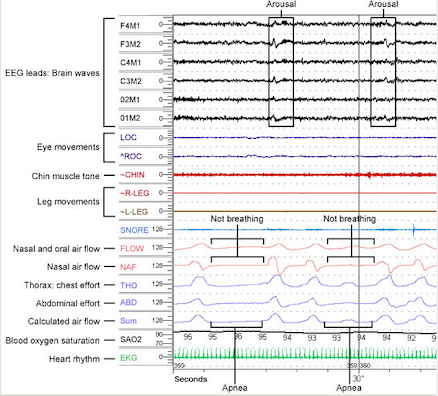The Takeaway
To confirm a diagnosis of obstructive sleep apnea, you must participate in a sleep study. During a study, your sleep is monitored. The subsequent data is evaluated by a sleep specialist.
Testing for apnea falls into two general categories: polysomnography and limited channel monitoring.
Polysomnography

Polysomnography is the simultaneous recording of multiple physiologic signals during sleep. The signals generally included are: brain waves (electroencephalogram, or EEG); eye movements (electrooculogram, or EOG); chin muscle activity (chin electromyogram, or EMG); air flow from the nose and mouth; chest and abdominal movement; blood oxygen levels (oximetry); heart rate and rhythm (electrocardiogram, or ECG); and leg movements (leg electromyogram, or EMG). The EEG, EOG, and chin EMG signals are necessary to determine whether a person is awake or asleep, and also to determine whether his or her pattern of sleep is normal. For an example of the kind of data that can be collected in a sleep lab, visit the Sleep Lab Interactive and check out the apnea example.
Polysomnography is usually performed in a sleep laboratory with monitoring by a sleep technician. In people with OSA, polysomnography recordings demonstrate repetitive episodes of breathing pauses despite efforts to breathe (see Figure 6). It is considered the "gold standard" for diagnosis.
Advantages of polysomnography include the following:
- Technician is continuously present to adjust signals for optimal recording
- Sleep is recorded
- Other sleep conditions may be observed
Disadvantages are:
- Recording is performed in an unfamiliar environment
- More expensive than limited channel monitoring
Limited Channel Monitoring

With this test, monitors record a smaller number of physiologic signals than during polysomnography. Generally the signals are focused on breathing and blood oxygen levels. With these monitors alone, sleep cannot be precisely determined but can be estimated by recordings of body movement (actigraphy). This test is usually performed in the home in the absence of a sleep technician, but sometimes it is used in a sleep laboratory setting. Increasingly, people who have a high likelihood of OSA and have few other medical conditions are tested via limited channel monitoring. This method is also used for follow-up testing of people with OSA, to determine whether their treatments are effective.
Advantages of limited channel monitoring:
- Signals are obtained in a more normal sleep environment
- Costs are lower than with polysomnography
Disadvantages are:
- Technician is not available to ensure high-quality recordings
- Greater failure rate, which can require repeat study
- Sleep is not recorded
Other Diagnostic Tests

Sometimes other tests are done in addition to polysomnography or limited channel monitoring. However, by themselves, the following tests are inadequate to confirm a diagnosis.
- Oximetry: This is a method of recording blood oxygen levels alone. It is not a substitute for either polysomnography or limited channel monitoring because low blood oxygen levels can be caused by disorders other than OSA. In addition, some people with OSA have little reduction in blood oxygen levels.
- Sleep Questionnaires and Diaries: These provide useful information to understand a person's sleep habits and patterns. However, by themselves they are insufficient to confirm or exclude the diagnosis of OSA.
- Blood Tests: There is no blood test for OSA. Some tests, like thyroid hormone level tests, may allow a healthcare practitioner to determine whether an associated medical condition is present.